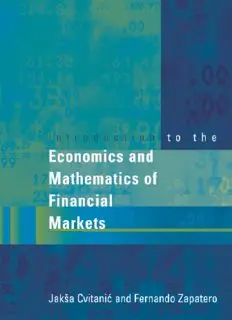
Introduction to the economics and mathematics of financial markets PDF
Preview Introduction to the economics and mathematics of financial markets
Introduction to the Economics and Mathematics of Financial Markets This page intentionally left blank Introduction to the Economics and Mathematics of Financial Markets Jaksˇa Cvitanic´ and Fernando Zapatero The MIT Press Cambridge, Massachusetts London, England (cid:2)c 2004 Massachusetts Institute of Technology All rights reserved. No part of this book may be reproduced in any form by any electronic or mechanical means (including photocopying, recording, or information storage and retrieval) without permission in writing from the publisher. This book was set in 10/13 Times Roman by ICC and was printed and bound in the United States of America. Library of Congress Cataloging-in-Publication Data Cvitanic´, Jaksˇa Introduction to the economics and mathematics of financial markets / Jaksˇa Cvitanic´ and Fernando Zapatero. p. cm. Includes bibliographical references and index. ISBN 0-262-03320-8 ISBN 0-262-53265-4 (International Student Edition) 1. Finance—Mathematical models—Textbooks. I. Zapatero, Fernando. II. Title. HG106.C86 2004 332.632(cid:2)01(cid:2)515—dc22 2003064872 To Vesela, Lucia, Toni and Maitica, Nicola´s, Sebastia´n This page intentionally left blank Contents Preface xvii I THE SETTING: MARKETS, MODELS, INTEREST RATES, UTILITY MAXIMIZATION, RISK 1 1 Financial Markets 3 1.1 Bonds 3 1.1.1 Types of Bonds 5 1.1.2 Reasons for Trading Bonds 5 1.1.3 Risk of Trading Bonds 6 1.2 Stocks 7 1.2.1 How Are Stocks Different from Bonds? 8 1.2.2 Going Long or Short 9 1.3 Derivatives 9 1.3.1 Futures and Forwards 10 1.3.2 Marking to Market 11 1.3.3 Reasons for Trading Futures 12 1.3.4 Options 13 1.3.5 Calls and Puts 13 1.3.6 Option Prices 15 1.3.7 Reasons for Trading Options 16 1.3.8 Swaps 17 1.3.9 Mortgage-Backed Securities; Callable Bonds 19 1.4 Organization of Financial Markets 20 1.4.1 Exchanges 20 1.4.2 Market Indexes 21 1.5 Margins 22 1.5.1 Trades That Involve Margin Requirements 23 1.6 Transaction Costs 24 Summary 25 Problems 26 Further Readings 29 2 Interest Rates 31 2.1 Computation of Interest Rates 31 2.1.1 Simple versus Compound Interest; Annualized Rates 32 2.1.2 Continuous Interest 34 viii Contents 2.2 Present Value 35 2.2.1 Present and Future Values of Cash Flows 36 2.2.2 Bond Yield 39 2.2.3 Price-Yield Curves 39 2.3 Term Structure of Interest Rates and Forward Rates 41 2.3.1 Yield Curve 41 2.3.2 Calculating Spot Rates; Rates Arbitrage 43 2.3.3 Forward Rates 45 2.3.4 Term-Structure Theories 47 Summary 48 Problems 49 Further Readings 51 3 Models of Securities Prices in Financial Markets 53 3.1 Single-Period Models 54 3.1.1 Asset Dynamics 54 3.1.2 Portfolio and Wealth Processes 55 3.1.3 Arrow-Debreu Securities 57 3.2 Multiperiod Models 58 3.2.1 General Model Specifications 58 3.2.2 Cox-Ross-Rubinstein Binomial Model 60 3.3 Continuous-Time Models 62 3.3.1 Simple Facts about the Merton-Black-Scholes Model 62 3.3.2 Brownian Motion Process 63 3.3.3 Diffusion Processes, Stochastic Integrals 66 3.3.4 Technical Properties of Stochastic Integrals∗ 67 3.3.5 Itoˆ’s Rule 69 3.3.6 Merton-Black-Scholes Model 74 3.3.7 Wealth Process and Portfolio Process 78 3.4 Modeling Interest Rates 79 3.4.1 Discrete-Time Models 79 3.4.2 Continuous-Time Models 80 3.5 Nominal Rates and Real Rates 81 3.5.1 Discrete-Time Models 81 3.5.2 Continuous-Time Models 83 Contents ix 3.6 Arbitrage and Market Completeness 83 3.6.1 Notion of Arbitrage 84 3.6.2 Arbitrage in Discrete-Time Models 85 3.6.3 Arbitrage in Continuous-Time Models 86 3.6.4 Notion of Complete Markets 87 3.6.5 Complete Markets in Discrete-Time Models 88 3.6.6 Complete Markets in Continuous-Time Models∗ 92 3.7 Appendix 94 3.7.1 More Details for the Proof of Itoˆ’s Rule 94 3.7.2 Multidimensional Itoˆ’s Rule 97 Summary 97 Problems 98 Further Readings 101 4 Optimal Consumption/Portfolio Strategies 103 4.1 Preference Relations and Utility Functions 103 4.1.1 Consumption 104 4.1.2 Preferences 105 4.1.3 Concept of Utility Functions 107 4.1.4 Marginal Utility, Risk Aversion, and Certainty Equivalent 108 4.1.5 Utility Functions in Multiperiod Discrete-Time Models 112 4.1.6 Utility Functions in Continuous-Time Models 112 4.2 Discrete-Time Utility Maximization 113 4.2.1 Single Period 114 4.2.2 Multiperiod Utility Maximization: Dynamic Programming 116 4.2.3 Optimal Portfolios in the Merton-Black-Scholes Model 121 4.2.4 Utility from Consumption 122 4.3 Utility Maximization in Continuous Time 122 4.3.1 Hamilton-Jacobi-Bellman PDE 122 4.4 Duality/Martingale Approach to Utility Maximization 128 4.4.1 Martingale Approach in Single-Period Binomial Model 128 4.4.2 Martingale Approach in Multiperiod Binomial Model 130 4.4.3 Duality/Martingale Approach in Continuous Time∗ 133 4.5 Transaction Costs 138 4.6 Incomplete and Asymmetric Information 139 4.6.1 Single Period 139
